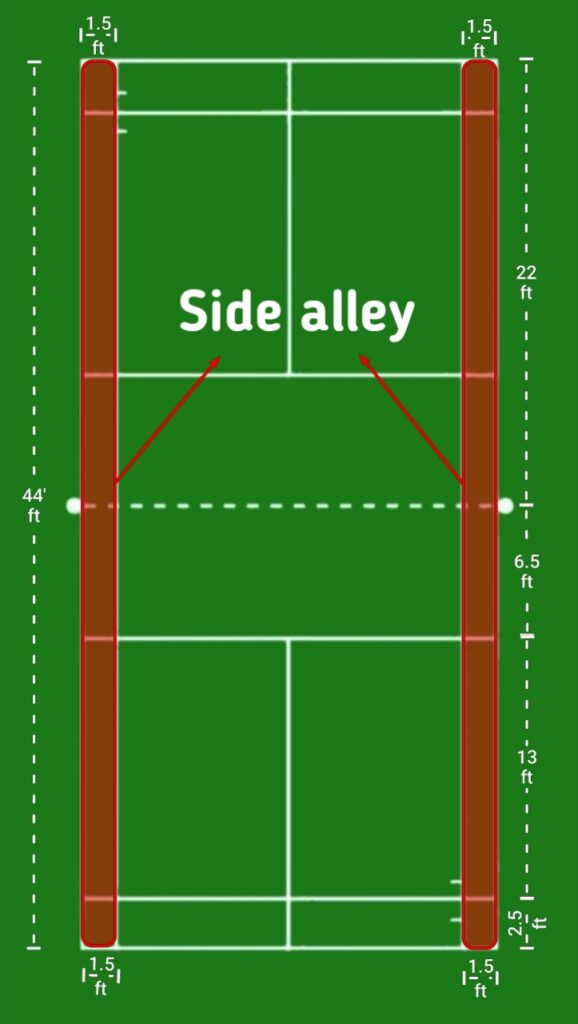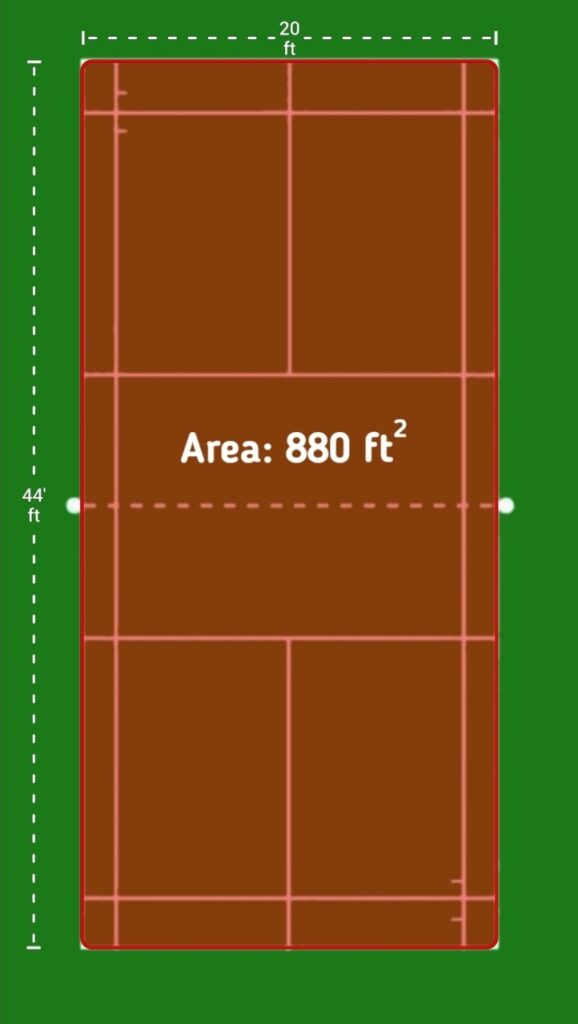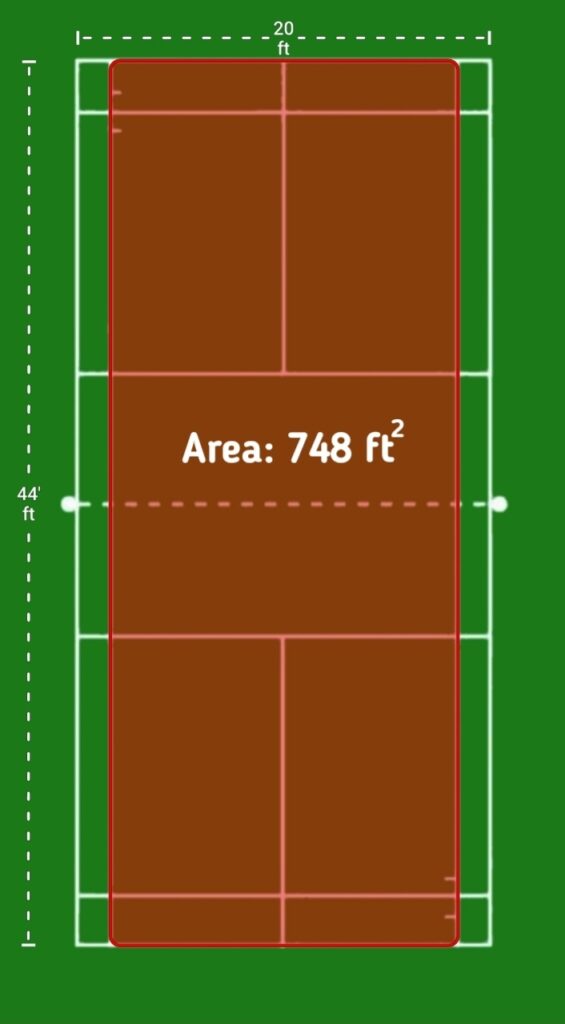Badminton Court Measurement in feet
Introduction
Welcome to our complete guide about the measurements that make up a badminton court. This article will walk you through the important details whether you wish to set up a court or are a player, fan, or both.. We’ll talk about things like how long and wide the court is, where the lines are, and how high the net should be. where the lines should be drawn, and how high the net should be. You’ll have a solid understanding of how these measurements affect the badminton game by the end. Let’s dive into the realm of badminton court dimensions now! Whether you are a beginner or an expert player, this blog will help you comprehend how big the court is.
Measurement of a Full Badminton Court in Feet
A standard full badminton court measures 44 feet in length and 20 feet in width. These Measurements define the court’s playing area, which is the scene of all the thrilling rallies, serves, and volleys.

Measurement of a Singles Badminton Court in Feet
The length and width of a singles badminton court are 44 and 17 feet, respectively. One player per side of the net is the intended configuration for this particular court size. For competitive singles matches, measurements ensure an even playing field.. The boundaries, service areas, and other crucial playing zones are indicated on the court with various lines.

Measurement of the Badminton Alleys in Feet
The doubles alleys in a badminton court extend the width of the court, adding extra space for doubles matches. Each doubles alley is 1.5 feet wide, making the total width of the court, including both alleys, 22 feet for a doubles match. When it comes to doubles matches, those alleyways really come into play.

What is the Area of a Full Badminton Court in Square Feet?
A full badminton court has a total playing space of about 880 square feet, which includes both the singles and doubles sections. The 44 foot length and 20 foot width of the court serve as the basis for this computation. It’s vital to keep in mind that this measurement excludes any additional regions, like spectator areas, clear spaces around the court, and other non-playing zones.

What is the Area of a Singles Badminton Court in Square Feet?
A singles badminton court has a surface size of around 748 square feet and is 44 feet long by 17 feet wide. The playable court area where the game is being played is taken into consideration in this calculation. Remember that any non-playing areas or additional spaces around the court are not included in this measurement.

What are the Dimensions of a Singles Service Area?
The singles service area has a width of 8 feet 6 inches and a length of 15 feet 6 inches. This yields a surface area of about 131.75 square feet. Multiplying the breadth (8.5 feet) by the length (15.5 feet) will yield the answer.

What are the Dimensions of a Doubles Service Area?
The double service area has a 130 square foot footprint and is 10 feet wide by 13 feet long. You must multiply the width (10 feet) by the length (13 feet) to arrive at this calculation.

How Thick are the Lines On a Badminton Court?
badminton court’s lines are normally about 2 inches wide. The sidelines, baselines, service lines, and centerline are just a few examples of the zones and boundaries that these lines are used to define on the court. The precision and fairness of the game are guaranteed by the uniform width of these lines, which makes it easy for players and officials to determine whether shots are in or out of bounds.
FAQs
Q1: What are the dimensions of a standard badminton court?
A standard badminton court has dimensions of 13.4 meters (44 feet) in length and 6.1 meters (20 feet) in width for singles matches. For doubles matches, the width remains the same, but the length is extended to 13.4 meters (44 feet).
Q2: What is the height of the net above the ground?
The net should be suspended at a height of 1.55 meters (5 feet 1 inch) at the edges and 1.524 meters (5 feet) at the center.
Q3: Are there any specific markings on the court?
Yes, there are specific markings on the court. The court is divided into halves by a centerline, and there are short service lines (1.98 meters from the net) and long service lines (5.18 meters from the net) that indicate the service area. There are also boundary lines along the length and width of the court.
Q4: How far should the side boundary lines be from the doubles sideline?
The side boundary lines should be 0.76 meters (2 feet 6 inches) away from the doubles sideline.
Q5: What is the purpose of the “T” shape formed by the centerline and the short service line?
The “T” shape formed by the centerline and the short service line is used to determine the correct serving and receiving positions during a doubles match. The serving side serves from the right side of the “T” and the receiving side stands on the left side.
Q6: Are there any specific guidelines for court construction materials?
While there aren’t strict guidelines for construction materials, the playing surface is typically made of wood or synthetic materials like rubberized mats. The surface should provide good traction, be level, and free from any obstructions.
Q7: Can the court dimensions vary for recreational play?
Yes, for recreational play, the court dimensions can be adjusted based on the available space. However, it’s recommended to try to maintain the standard dimensions as closely as possible to ensure a fair and enjoyable game.
Q8: Are there any regulations for lighting and surroundings of the court?
There are no specific regulations for lighting or surroundings, but well-lit courts and clear surroundings enhance safety and gameplay. Adequate lighting helps players see the shuttlecock clearly, and having enough space around the court prevents interference with play.
Q9: What is the purpose of the “No Volley Zone” or “Kitchen” in badminton?
The “No Volley Zone,” also known as the “Kitchen” or “Non-Volley Zone,” is an area near the net where players are not allowed to hit the shuttlecock on the fly (volley) during a serve or a return. This prevents players from dominating the net area too aggressively and promotes fair play.
Q10: Can court dimensions differ in professional tournaments?
In professional tournaments, the court dimensions must adhere strictly to the standard measurements to ensure uniformity and fairness in gameplay.



